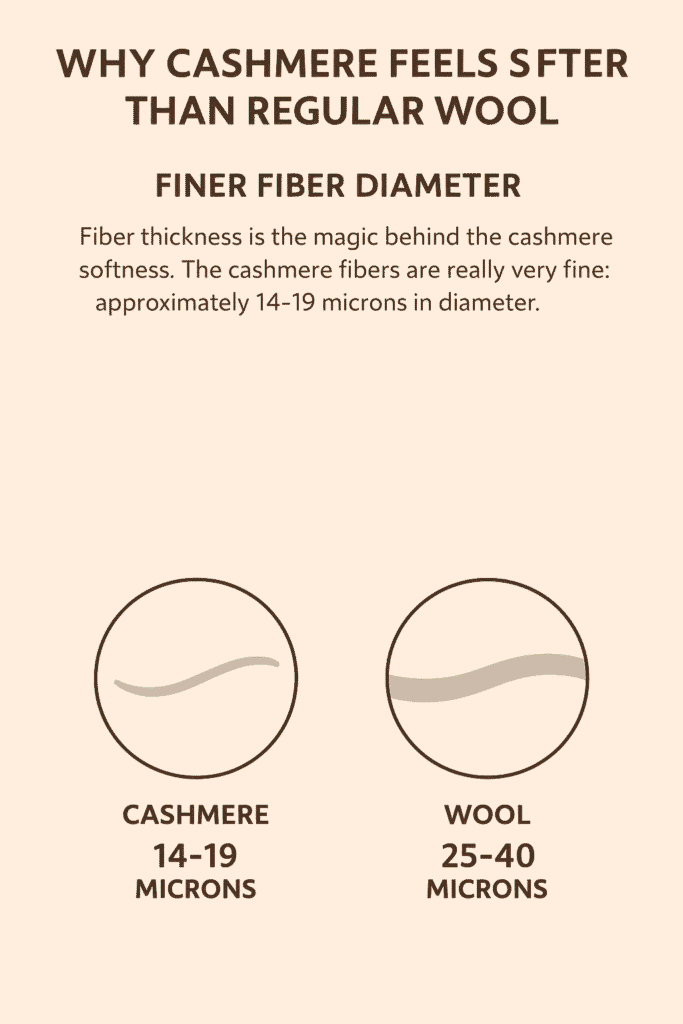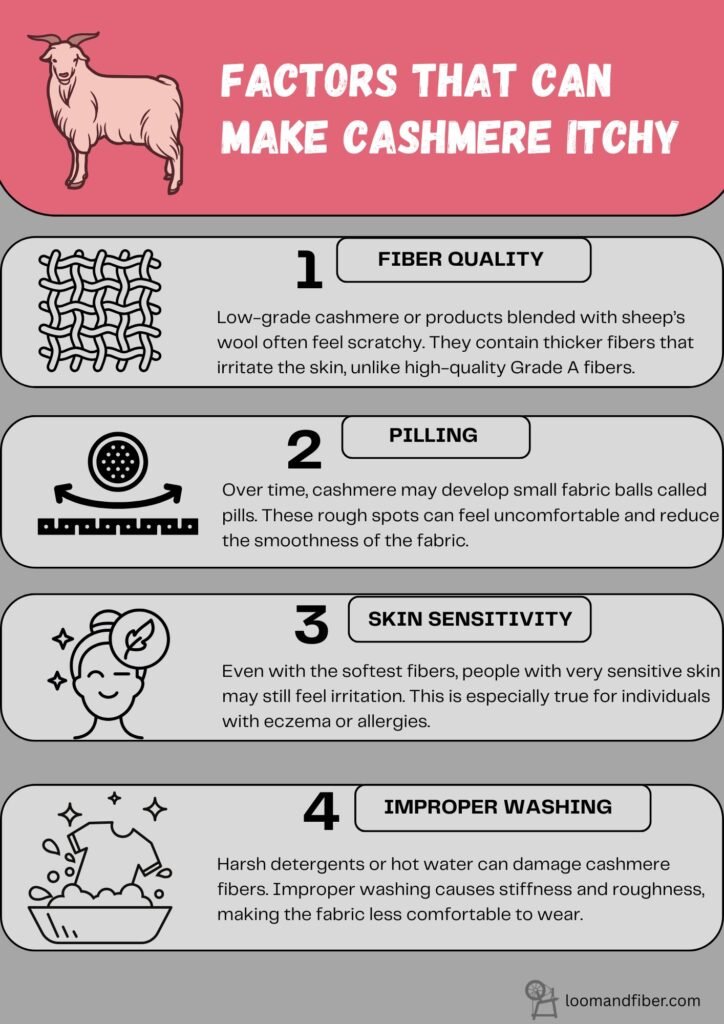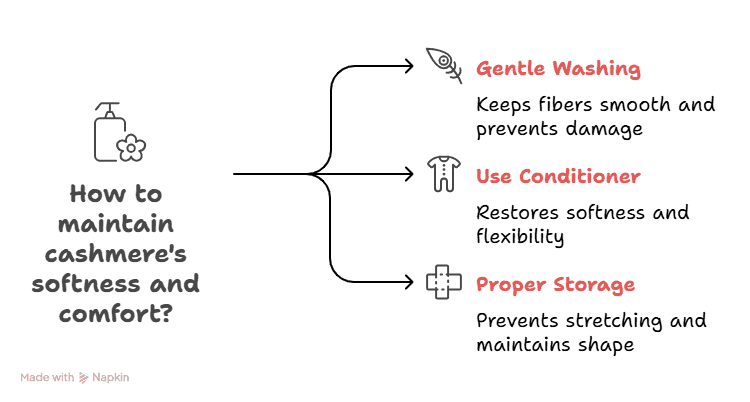Introduction: Cashmere’s Luxury and Comfort
Cashmere has been regarded as a luxury fabric in the world long enough. It has an amazing softness, warmth and lightness, and it is frequently applied to high end sweaters, scarves, and coats. People have been in love with its capacity to give warmth yet not weightiness over centuries. Nevertheless, not all first-time customers make purchases due to the presence of one feature common to many of them: is cashmere wool itchy?
It is an instinctive question because people generally think of wool as being scratchy. Cashmere fibers are far finer and smoother compared to regular wool and are therefore not so irritating to the skin. Nonetheless, the degree of comfort is based on numerous factors, such as the quality of the cashmere, its way of processing, and even on the sensitivity of the skin individually. To answer the question adequately, it is important to find out why cashmere feels different to ordinary wool and what makes it unique.
Is Cashmere Wool Itchy?
The immediate reply is no–reality, high-quality cashmere is not itchy. Cashmere fibers are very fine, unlike the wool of ordinary sheep, which in some cases can cause a roughness to the skin. This provides them with a soft luxurious feel. Not every cashmere product is the same, however. There are blends that have normal wool in them and this can be uncomfortable. Less soft and even a little scratchy can also be lower-grade cashmere with shorter fibers.
The other reason is personal skin sensitivity. Even fine fibers can be irritating to people who have such conditions as eczema. Thus, authentic, high quality cashmere is typically soft and non-itchy although there are possibilities of a differing experience. The essentials are in quality of fiber, construction of fabric and care.
Why Cashmere Feels Softer Than Regular Wool
Finer Fiber Diameter

Fiber thickness is the magic behind the cashmere softness. The cashmere fibers are really very fine: approximately 14-19 microns in diameter. Commonly, on the other hand, the fibers of the wool of sheep measure 25 microns or more. The fibers of these tiny cashmere are easy to bend and touch silky-smooth on the skin. Their thinness makes them move softly and does not poke or scratch. In other words, the finer the fiber the finer the feel. That is why finest strands of cashmere make it feel as a soft cloud compared to rougher ones of coarse wool.
Smoother Surface Texture
Cashmere is also extremely smooth. The scales that are microscopic in wool fibers are able to seize the skin making it itchy. These scales are far smaller and less in cashmere. That is, the surface of the cashmere fiber is smoother, therefore sliding over the skin rather than scratching it. With this friction is considerably decreased. Consequently, despite the fact that cashmere is still wool, it is not a prickly fabric, but soft and supple. According to luxury brand guides, the minute scales of cashmere cause it to have an ultra-soft feeling on the skin, which is a part of that famous soft feel.
Hypoallergenic Nature
Cashmere is also more hypoallergenic by nature, thus making it feel gentler. It is much less woolly, with little or no lanolin, or the waxy oil in wool that usually causes itch or an allergy. Cashmere has virtually no lanolin and will therefore not irritate sensitive skin as easily. Indeed, cashmere can be worn by most individuals who are allergic to wool because of its Lanolin content. The cashmere fine fibers simply just do not contain the greasy allergens that exist in regular wool. Combined, the chemical composition and the composition of the fibers of cashmere make it a very hospitable material to wear among people who have sensitive skin.
Factors That Can Make Cashmere Itchy

Fiber Quality
Not every cashmere is created equal and fiber quality plays an important role in determining softness. Cashmere in high grade incorporates long fines that are smooth to touch on the skin. Low-grade versions, however, have a much thicker, shorter fiber which forms a less smooth texture. Others are mixed with wool of sheep or synthetic material that may make one feel itchy.
Pilling
Cashmere is fragile and with time, it can form minute balls of fabric referred to as pills. These pills are caused when there is a breaking and a mingling of fibers as a result of friction. Although, pilling is natural, it leaves the garment with a roughly textured surface making it less soft. To achieve the smooth look and feel, regularly replacing pills with a fabric comb will help to address discomfort and ensure the softness.
Skin Sensitivity
Although, cashmere is significantly soft as compared to sheep wool, individuals with extremely sensitive skin can be irritated. Such conditions as eczema, psoriasis, or dry skin may make fibers feel more scratchy than they are. Even the Grade A cashmere can be not entirely comfortable to these people. To reduce discomfort, it is possible to choose ultra-fine fibers and put on a thin layer of cotton underwear.
Improper Washing
How you treat cashmere may greatly influence the feel and the softness of the fabric. Washing with harsh detergents, hot water or machine washing, may ruin the fragile fibers. This causes stiffness, shrinkage and rough textures that make it itchy on the skin. In order to retain softness, cold water with light detergent always needs to be hand washed and the garment dries flat.
Cashmere vs Other Wools: Which Is Itchier?
Cashmere vs Sheep Wool ( Lambswool ).
Compared to the normal sheep wool, cashmere is the obvious winner in softness. Normal lambswool or merino has lanolin and coarser fibers in it and can become itchy. In comparison, fibers in cashmere are finer and lanolin-free. Individuals that feel that woolen sweaters are not comfortable are normally aware of the fact that cashmere is soothing. In short, ordinary sheep wool is more prone to itchiness, as compared to cashmere, which is much smoother and more silky to skin.
Cashmere vs Merino Wool
Merino wool is softer than generic wool but it still is not as soft as cashmere. Cashmere, according to industry experts, is much less itchy than merino since it does not have lanolin. Merino provokes lanolin allergies in those who are sensitive to it, but cashmere does not. They are both fine fibers, with cashmere of an extra-light, cloud-like feel. Cashmere is chosen as direct-contact clothing by many on the basis of a more luxurious feel. In essence, when merino is soft to you but a little itchy, cashmere will probably be more comfortable.
Cashmere vs Alpaca
Alpaca wool is also extremely fine and wool of the alpacas is usually regarded as one of the softest natural fabrics. Alpaca is cashmere-like, hypoallergenic and without lanolin. Both alpaca and cashmere are practically not as itchy as sheep wool. The views are divided about which is less hard with cashmere being conferred as soft gold and being valued in giving an ultra smooth feel to the hand whilst alpaca fibers are hollow and thus tend to feel warm. Alpaca is said to be warmer and durable, however, cashmere is smoother. The two are soft to touch, but cashmere grabs a slight advantage over the fineness of its grain.
Cashmere vs Angora Wool
Another luxury fiber that is soft is the Angora wool (the Angora rabbit). Angora fibers range between 12 and 16 microns, which is even even finer than cashmere in most instances. Angora is light and fluffy and by no means always itchy. As a matter of fact, it has been termed as slick and equally compatible with tender skin. The major distinctions: angora is lighter and less cold (it has a hollow center), cashmere is stricter and is more shiny. Both fibers are not itchy in nature; it just depends on individual preference as to which one feels more comfortable, the ultra-soft angora or the smooth cashmere. Both are softer than common wool.
How to Choose Non-Itchy Cashmere
Quality Grade: Choose the best cashmere (the one that is labeled Grade A). The expensive cashmere involves long fine fibers that are spun in multi-ply yarn to be strong and thin. This high quality wool is pilling resistant and actually silky. When a garment is rough or has loose strands, then it is not of high quality.
100% Cashmere Content: See the label of 100 percent cashmere. Do not mix with wool or artificial fibers, since even a few percent of coarse wool can spoil the touch. True cashmere sweaters are more expensive, but blends will nearly always be scratchier. A straight up cashmere brand is an indicator that the fabric is going to be itch-free.
Authority Figure: Take into account the origin of the cashmere. Climate and breeding give regions such as Inner Mongolia, China and part of Central Asia the best cashmere. The cashmere of inner Mongolia is commonly in demand due to the extra-fine cotton. The factor of buying reputable brands or co-ops which assure the origin and purity of the wool assists in ensuring softness.
Softness Test: Before buying then do a touch test. Real cashmere must be extremely soft, and it must be so in your hands. Rub it on the cheek or the wrist: it ought to move easily, not leaving any prickles. When the fabric remains stiff or rough even on the tag, cross it off- good cashmere should not hurt. Trust your skin!
Tips to Make Cashmere Softer & More Comfortable

Gentle Washing
One of the best methods to maintain the softness and luxury of the cashmere is the proper washing of the piece. Always cold or lukewarm water and mild detergent designed to use on delicate fabric. The washing of hands prevents the fiber damage and also assists in preserving the natural smoothness of the garment.
Apply Conditioner or Baby Shampoo.
Cashmere is sensitive to gentle treatment and baby shampoo or conditioner miracles. These items are used in calming the fibers and regaining their siliciness after washing. Simply rinse to prevent unease of fabric hardening.
Proper Storage
The way that you keep cashmere is important in its comfort and durability. Cashmere should always be folded, not hung or it may stretch the fibers. It also avoids damage of dust and moths and therefore it remains soft when kept in a breathable bag.
Benefits of Cashmere Wool Beyond Softness
- Excellent Insulation – Cashmere offers the warmness of nature and is lightweight so it can be used even in cold weather.
- Temperature Control – The fibers adjust to the body temperature and make you feel comfortable in cool and warm weather.
- Lasting Power- Cashmere clothing will last years with revenue provided that they are well-kept.
- Elegant Drape Cashmere – The Drape is sleek and elegant and it looks exquisite.
- Luxury Investment – Cashmere is a classic wardrobe that is comfortable, beautiful and durable.
Conclusion-
So, is cashmere wool itchy? The fact is that even quality cashmere wool is not often itchy in case it is taken care of properly. It is non-lanolin and has fine fibers and unparalleled softness that distinguishes it among the common types of wool. Although this may make some discomfort to lower-grade products or inappropriate washing, the highest quality cashmere retains its smoothness and luxurious sensation. When investing in real cashmere, one could have a few years of warmth, comfort and grace. The classic fabric can be among the most comfortable and luxurious fabrics in the world with the right decision and attention.
Read More>> About the manufacturing of cashmere wool.
FAQs
When your cashmere sweater is itchy, it could be woven with a less expensive type of fibers or combined with standard wool. These coarser fibres may be more coarse to the skin than pure cashmere. Incorrect washing will cause fibers to become hard and uncomfortable as well.
Yes, the majority of sensitive skin people can find cashmere very soft and calming to touch. It does not have lanolin, unlike that of sheep which is known to be irritating at times. Nevertheless, even people who have extremely sensitive skin can be slightly uncomfortable.
With the proper care and frequent use, cashmere tends to soften. A low level of detergent or baby shampoo washing can relax the fibers. The fabric can become more comfortable as time goes by adjusting to your body.
The soft, warm, and light feel of real cashmere makes one feel it. Pieces of high quality are also expected to be labeled with the word, 100% Cashmere. Counterfeits can be coarse, bulky or have mixtures that make them less soft.

I like how you broke down the reasons why cashmere feels softer than regular wool, especially the finer fiber diameter explanation—it really clarifies why it’s considered such a luxury fabric. I’ve noticed that sensitivity often comes down to quality and care, so the section on washing and storage tips is super practical. It’s interesting to see how it stacks up against other wools like merino and alpaca, since those are often marketed as soft alternatives too.
Cashmere’s itchiness depends on quality and skin sensitivity! High-grade cashmere with longer fibers (over 15mm) feels luxuriously soft due to smoothed scales. Your point about keratin allergies causing reactions is crucial—many blame “prickliness” when it’s actually immune responses. The washing technique tips to maintain softness are practical gold!
Its like you read my mind! You seem to know so much about this, like you wrote the book in it or something. I think that you could do with a few pics to drive the message home a little bit, but other than that, this is excellent blog. An excellent read. I will definitely be back.